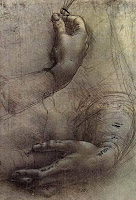
I have always loved the way shadows are the underlying abstraction in even the most realistic of paintings or drawings. Perhaps because I have spent so much time in countries where white walls are the most perfect surfaces for shadows, I frequently find them more interesting than their "source objects".
Leonardo daVinci once said, "Shadows have their boundaries at certain determinable points. He who is ignorant of those will produce work without relief; and the relief is the summit and the soul of painting." He was one of the pioneers of chiaroscuro, the play of light and dark that helps describe an object; before the Renaissance, artists did not depict objects or people using this system of darks and lights. Leonardo's study of hands and arms illustrates his study of the shadows that help define these arms and hands.
Study of Female Arms and Hands, Leonardo da Vinci (Image Courtesy of Royal Library, Windsor)
What is Leonardo's subtext is his message - look, look, look at what you are depicting. Study the way the light falls on the object. Examine the shadows, the way the shadow is darkest near the object and tapers out as it gets further from the object casting the shadow. Remember to look for the reflected light near the object that is bounced back into the shadow from any light-coloured object, like an egg.
The shadows define the curves and angles of every object, allowing us to understand their configurations - like a visual language whose vocabulary one needs to acquire and practice. As all the light outside comes from the sun, the shadows will move, change, evolve as the sun moves across the sky. Leonardo's Study for the Kneeling Leda, done with bold in hatching, shows what he was talking about in the use of shadows.
Study for a kneeling Leda, 1503-07
Black chalk, pen and ink on paper, 126 x 109 cm
Museum Boijmans Van Beuningen, Rotterdam
Accurate observation of light, and thus shadows, will implicitly tell the viewer what times of day the artist was working, and even indicate at what latitude the painting was done if carefully examined. The constant change in light is one of the main challenges to plein air art. It is a non-stop gallop as one can never work fast enough, it seems, to catch up with the movement of light and shadows. That is where quick sketches indicating shadows and light angles can help greatly later on. The light situation is also one of the main reasons why artists resort to photographs as the shadows are suddenly frozen. Nonetheless, working solely from photos tends to produce airless art, even if it is easier and an artist can control the process a little better than just working plein air.
I am reminded that there is another dimension of this need to look at shadows to find the "relief" for a drawing - at the moment, I am in the middle of doing a silverpoint drawing of ginger lilies, those wonderful, fragrant white butterfly-like flowers. I picked the head with the buds half open. With the indoors warmth, the flowers are opening fast, changing all the time, and of course, the plays of lights and darks are constantly altering. Since silverpoint is slow, this is a constant juggling act to keep a coherent composition going, remain reasonably faithful to the flowers and yet use the light and shadows to tell about the graceful forms of these flowers. Using artificial light, even my faithful daylight-accurate Ott Lights, makes the shadows so harsh that it is not appealing, so I am working in daylight, with its own set of challenges.
Challenges, yes, but Leonardo was right – the play of light and shadow can be the summit and soul of a piece of art.


